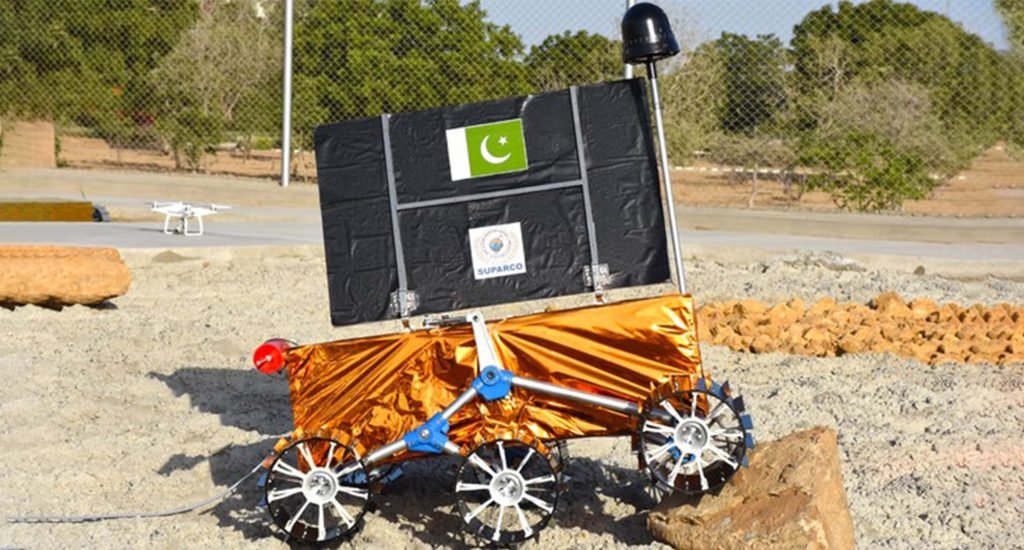Pakistan’s First Lunar Rover to Join China’s Chang’e-8 Mission
- Abeera Marium Siddiqui
- November 14, 2024
- 3:44 pm
- 29
- Technology

Pakistan is set to make history by joining China’s Chang’e-8 mission in 2028 with its first lunar rover. This collaboration, announced by the Pakistan Space and Upper Atmosphere Research Commission (SUPARCO), is a major leap forward for Pakistan’s space program. It showcases the country’s growing ambition in space exploration.
Chang’e-8 and Pakistan’s Role in the Mission
China’s Chang’e-8 mission, part of the larger International Lunar Research Station (ILRS) initiative, aims to explore the Moon’s south pole. This area is known for its rough terrain and potential scientific value. SUPARCO’s 35-kilogram rover will join this mission, equipped to conduct experiments and gather data to understand the Moon’s surface better. “SUPARCO’s rover, with an approximate weight of 35 kilograms, will join China’s Chang’E 8 mission, which is part of the larger International Lunar Research Station (ILRS) project,” SUPARCO stated in its recent announcement.
Pakistan’s Rover and Its Mission Goals
SUPARCO’s rover has been designed specifically for this mission and is outfitted with advanced scientific tools. It’s tasked with studying lunar soil, mapping the lunar surface, and testing sustainable technologies that could one day support human presence on the Moon. The rover will conduct essential experiments to help scientists better understand the south pole’s conditions. “This collaboration marks a significant milestone for Pakistan’s space program, as SUPARCO’s indigenous rover will be part of the mission to explore the lunar surface,” SUPARCO said.
Why the Lunar South Pole?
The Moon’s south pole presents a unique challenge. The rough terrain and constant shadows make it difficult to navigate, but it also offers huge scientific potential. The south pole could hold valuable resources like water ice, which would be crucial for future lunar missions. SUPARCO’s collaboration with China targets these potential discoveries and is part of a broader plan to uncover what resources exist on the Moon. The data gathered by SUPARCO’s rover could inform not only future lunar missions but also potential human exploration projects down the line.
Experiments and Technology Testing
SUPARCO’s rover will be instrumental in conducting some of the mission’s most important experiments. These include lunar soil analysis, detailed surface mapping, and testing new technologies designed to make human life sustainable on the Moon. This groundbreaking work has implications for future lunar and planetary exploration. “The rover’s primary mission will focus on detailed exploration of the Moon’s south pole, an area believed to hold valuable resources, including water ice,” a SUPARCO spokesperson said. These experiments could lead to crucial discoveries that will support the ILRS project and future exploratory missions.
Pakistan-China Space Collaboration
Pakistan’s partnership with China on this mission underscores strong bilateral relations and a shared goal of advancing space exploration. In recent years, China has emerged as a leader in lunar exploration. This mission aligns with SUPARCO’s long-term goals of expanding its space capabilities. This partnership follows Pakistan’s iCube Qamar satellite launch with China’s Chang’e-6 mission in 2024, which placed a miniature satellite in lunar orbit. By participating in Chang’e-8, Pakistan gains a valuable opportunity to contribute to one of the most ambitious lunar projects of the decade.
Looking Ahead
The Chang’e-8 mission marks a major milestone for Pakistan’s space program, positioning the country as a player in lunar exploration. This collaboration with China not only enhances SUPARCO’s expertise but also highlights Pakistan’s growing role in international space research. The mission promises to open doors for future projects and scientific advancements.



